I can't believe I didn't catch this earlier! Great work so far. I will definitely be following. 
Gloria di Firenze - A MMU submod AAR
- Thread starter CJL78
- Start date
-
We have updated our Community Code of Conduct. Please read through the new rules for the forum that are an integral part of Paradox Interactive’s User Agreement.
You are using an out of date browser. It may not display this or other websites correctly.
You should upgrade or use an alternative browser.
You should upgrade or use an alternative browser.
I'm following from the very beginning and I hope for an epic AAR till the end.
Definitelely subscribed.
Definitelely subscribed.
Chapter IX - A Weak Duke Amongst Kings
"Nature has so created men that they are able to desire everything but are not able to attain everything: so that the desire being always greater than the acquisition, there results discontent with the possession and little satisfaction to themselves from it."
-Machiavelli
The First War for Naples
Francesco Stefano pushed his claim to the throne of Naples, and in April of 1599, he declared war on the southern kingdom.
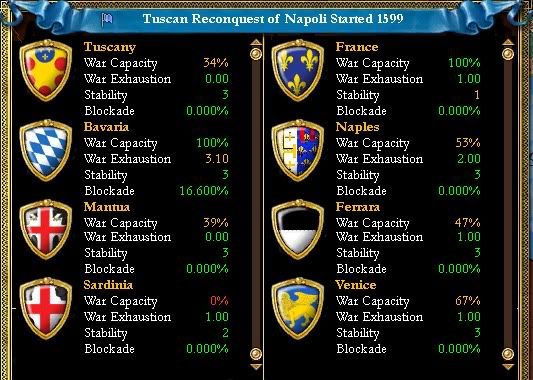
Francesco was supported by the Emperor Albrecht V, but the King of Naples was supported by his Valois cousin, the King of France. Venice and Ferrara also came to Naples' defense. Thus, the war quickly became the leading conflict between Protestants and Catholics of the time. Of the other major Catholics, however, Spain and Portugal were too overwhelmed at home and in the New World to care, while the Wittelsbachs in Scotland and England dared not help the French against their kin. The Habsburgs, for their part, were once again at odds with the Turks.
The war began well for the Protestants as Francesco Stefano crushed King Alfonso's outdated army at Naples. Another Tuscan army defeated Venetians at Friuli and besieged the town.
The Emperor, meanwhile, defeated a French attack into Franche-Comte and captured Valenciennes. The French met success in Artois, however, and marched into Flanders.
The lack of a meaningful Tuscan navy once again proved a problem, as most of the Grand Duchy was blockaded the entire war. A small force of Venetians and French sailors landed at Malta and eventually captured the island.
By November, the city of Naples had fallen and Tuscan troops moved into the rest of the kingdom. Friuli also fell to Tuscan forces and they marched on Istria as well. However, the war in France did not go as well. Valenciennes was retaken and the Franche-Comte fell as well. By the end of 1599, French forces had defeated the main Bavarian armies in the Netherlands and were besieging Luxembourg, Liege and Brugge.
By April, the last Neapolitan city had fallen and the Venetians had signed a truce. The war raged on through the summer months as the French mounted an extensive campaign into the Bavarian Netherlands. Their gains were slow in coming, however, and in October representatives of France, Tuscany, and the Emperor met at Nice to discuss peace. The French were eager to end the war but were powerless to stop the Tuscan occupation of Naples. Still, they refused to lose face. In the end, they allowed Francesco Stefano to occupy most of Naples, but the city and title itself would be retained by King Alfonso. In exchange, the Empire ceded Artois to the French Crown, and, in an effort to permanently divide Francesco's realm, the Demesne province of Modena was ceded to the Catholic Count of Ferrara, who soon styled himself a Margrave.
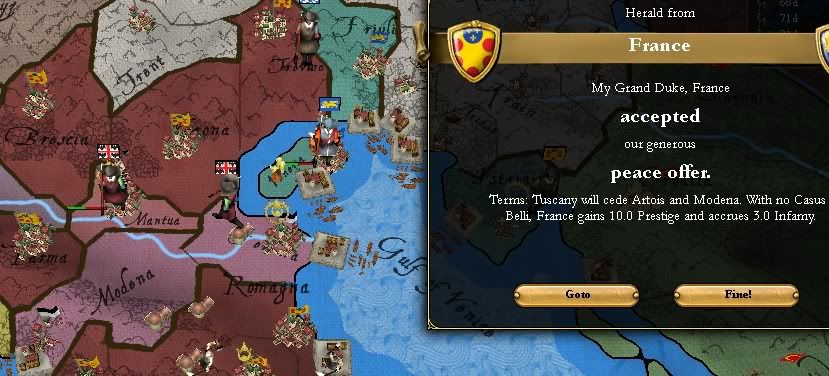
The "Weak Duke"
Many of the most outspoken nobles and war hawks at court were outraged that Francesco Stefano had conceded to French demands and left the King of Naples independent. Almost as outrageous to them was the Grand Duke's concession of Modena to Ferrara. Many still remembered how his predecessors had fought to wrest Modena from Ferraran control. They had agitated for a grand invasion of France through Switzerland. Francesco Stefano is still today considered the weakest, if not most prudent, of the Grand Dukes of Tuscany.
Still, the war was a win for the Grand Duke as most of the peninsula now answered to him. Even so, the demands of his administration were now stretched from the Venetian provinces and Parma in the north to the islands of Sicily and Malta in the south. The fall of Malta during the war had proved to the Grand Duke that the tiny island was not worth its weight, nor was Tuscany even able to defend it. He sold the island to the Mamluk Sultan a year later, for a few Tuscan merchants that had been captured and sold by Berber pirates.

[The Mamluks were the only ones who would take it, even for free!]
Francesco Stefano's last years were spent trying to consolidate the Neapolitan lands and placating the various factions who despised his rule. He began the Italian practice of hiring Swiss mercenaries as both an elite regiment and the personal bodyguard of the sovereign. Despite this, it was not surprising when, at the age of 28, the "Weak Duke" was assassinated while campaigning against rebels in Calabria.
His death was truly for the benefit of Tuscany, though, as his much more capable son, Carlo, came to the throne.
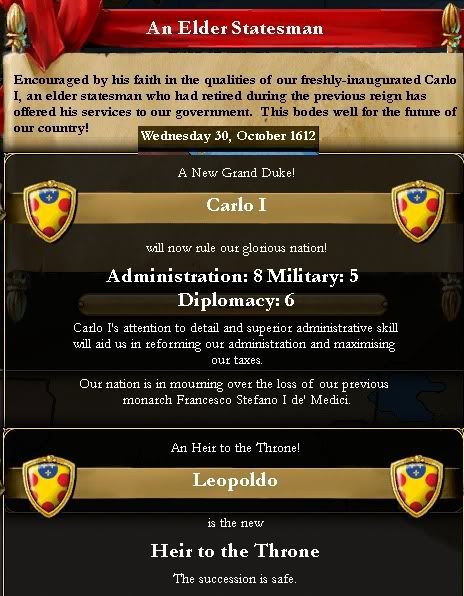
Last edited:
I can't believe I didn't catch this earlier! Great work so far. I will definitely be following.
I'm following from the very beginning and I hope for an epic AAR till the end.
Definitelely subscribed.
Thank you both.
Nobody wanted Malta? Even the Knights?I bet you didn't offer it to Naples?

I believe the Knights of Croatia had already been annexed by the Ottomans by this time. And yes, literally noone wanted Malta, or at least they all had "Impossible" or "Very Unlikely". And I checked this for every Mediterranean country, even Naples, but the Mamluks were the only ones with a "Maybe", and they accepted. Oddly enough, or perhaps not so odd, I have slightly better relations with most Muslims than I do with the 5 Catholic kingdoms (who are all at -200 permanently), though my relations with Austria are at least civil.
Last edited:
Just FYI to any readers: this AAR is/has been on hold while I've been busy near the end of the semester. It will continue sometime during or after the holidays
Take your time. Waiting patiently. Good luck with the end of semester, exams or whatever it is about 
Hope the scholastic endeavours weren't too stressful; I'm looking forward for this AAR's return! I included your mod in my game as well (though I had played up to 1470-something by that point).
Hope the scholastic endeavours weren't too stressful; I'm looking forward for this AAR's return! I included your mod in my game as well (though I had played up to 1470-something by that point).
Yeah, once I finished the last touches I edited my save game to turn all the Greeks back to Orthodox.
Not to worry, this AAR will continue! In fact, I've been playing here and there and I have played 100 years further to 1712 but with all my work to do just haven't found the will to sit down and write up the chapters. Once I do I'll have 850 screens and counting to go through to write the story!
And what an exciting story it is! The Medicis are not ones to sit quietly and twiddle their thumbs. Wars in a variety of far-off places are sure to come once finals and a short vacay are complete. Here's a teaser that I just can't hold in, but you'll have to wait for the AAR to see how it happened and how it turns out (btw I did not directly help them in any way):
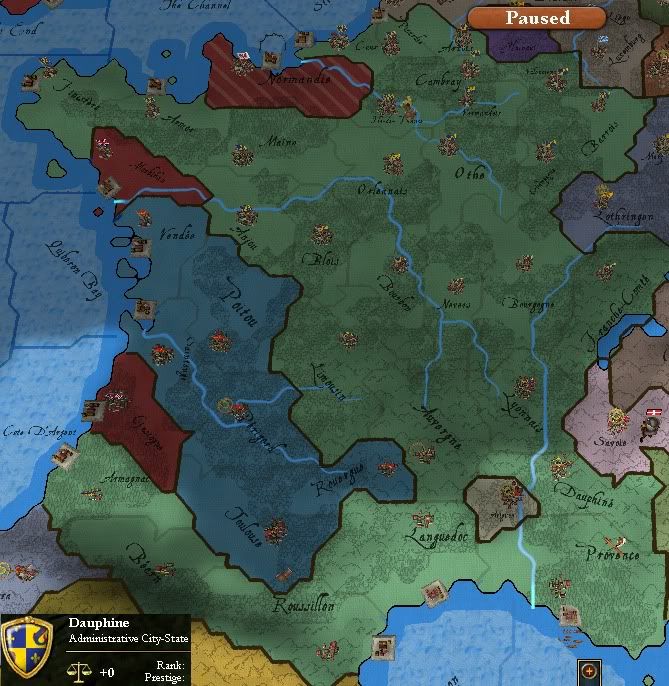
Last edited:
Wow, I can't wait to hear the story behind that. Sentimental me is glad Britain still has Normandy (even if Brandenburg or Pommerania seems to want to grab it), but... the state of France (or what used to be France) is astounding! And the Pope still has Avignon, too.
Should be a good one—enjoy the vacation!
Should be a good one—enjoy the vacation!
Last edited:
A very good AAR,CJL78 
This picture...My poor country !
A civil war between the elder son and his younger brother ?
This picture...My poor country !
A civil war between the elder son and his younger brother ?
France fail. Florence fantastic. Fight finished.
Um.... any other consonance I could add?
With a raging blizzard outside today, I had time on my hands, but for some reason didn't want to finish my submod for release. Instead, a long overdue update:
"You may have the universe if I may have Italy."
-Giuseppe Verdi
The Throne of Naples
With pirates becoming an increasing threat along Tuscany's much extended coastline, Carlo I's first act as Grand Duke was to pass a harsh new anti-piracy law.
His second act was to anull the treaty with France and Naples, and on February 1, 1615, he declared war on the fledgling kingdom of Naples, renewing his father's claim to the throne as his right.
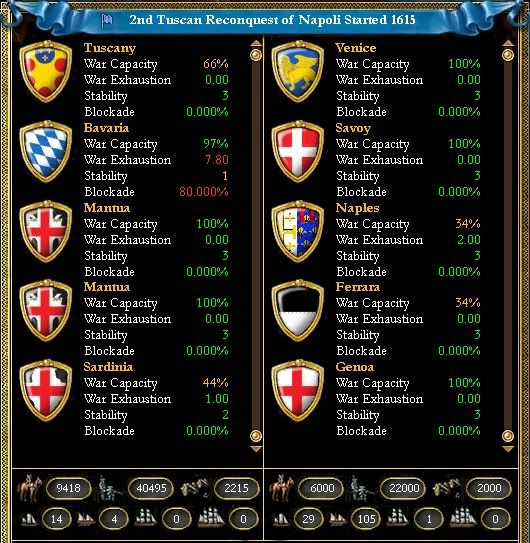
Henri III of France was in a tight spot to help his cousin this time around, as the French navy and professional army were in the New World fighting Mayans in the Yucatan. Spain was stable and at peace, so any attempt to stretch French forces further might provide the Spanish with a perfect opportunity to retake the Pyrenees. Furthermore, Austria and its allies, including Bavaria, were busy Crusading against the Turks. Though the Habsburgs considered coming to Naples' defense to try to keep Italy fractured, the Emperor Maximilian's immediate declaration of support for Tuscany meant they'd risk turning the Emperor from an ally to an enemy when they needed him most.
Nevertheless, the Italian states (except Milan who was involved in the Crusade as well) condemned the Tuscan aggression and began mobilizing for war. But it was Carlo who was prepared to fight. With 12,000 men, he invaded Naples from the northeast. Alfonso II hurriedly took control of his Neapolitan army and fled the city north to attack Roma, but in vain. Carlo's well-trained troops and engineers, combined with spies and sympathizers working in the city itself, took control of Naples in only 11 days. Carlo then marched north and defeated Alfonso outside Rome, and the Kingdom of Naples was added to the Crown of Tuscany. Carlo then marched north to face the Ferraran army besieging Florence. They fought galiantly but were overwhelmed by the superior Tuscan forces. Fighting in Ferrara (including Modena) against Ferraran and Genoese militias continued for months, as the Ferraran towns and cities put up staunch resistance in the hills of central Italy.
In the north, Carlo's second army of 16,000 men marched into Venetian territory and captured Friuli within two weeks. Securing passage through Habsburg Austria, they reached Istria two months later.
Seeing the stiff resistance of Ferrara and Genoa, the Emperor called for peace since Carlo had gotten what he wanted: Naples. While Carlo clearly had his eyes on annexing Ferrara, he was in no position to take on the Emperor himself, and did not want to cause the Crusade against the Turks to fall apart. With minor concessions from Venice, he agreed to a truce.

The "Slavic Crusade"
Having secured the throne of Naples for himself, the ambitious Carlo began looking for more battles. Italy was off-limits for the time being.
The Habsburg-Ottoman war continued to rage in Croatia and Slovenia, and in 1618 France, having been somewhat humiliated by the Mayans in the Yucatan jungles, redirected its forces against the Turkish threat. However, the Habsburgs refused to let the heretic Carlo join the Crusade.
By late 1619, the Ottoman's hold on the Balkans began to collapse as Austrian forces broke through in Croatia. Revolts broke out all along the Danube as Hungarian, Croatian, Serbian, and Bulgarian rebels stormed Ottoman garrisons. As the Ottoman state temporarily collapsed, the opportunisitc Duke of Transylvania invaded from the north, seizing Belgrade for himself.
Grand Duke Carlo saw an opportunity. Diplomatically prevented from joing the war against the Turks, he declared his own 'Crusade' of liberation against Transylvania in support of Serbian nationalists. Transylvania was protected by the King of Poland, however Carlo responded by calling in his newest ally, the newly Protestant Duke of Livonia.
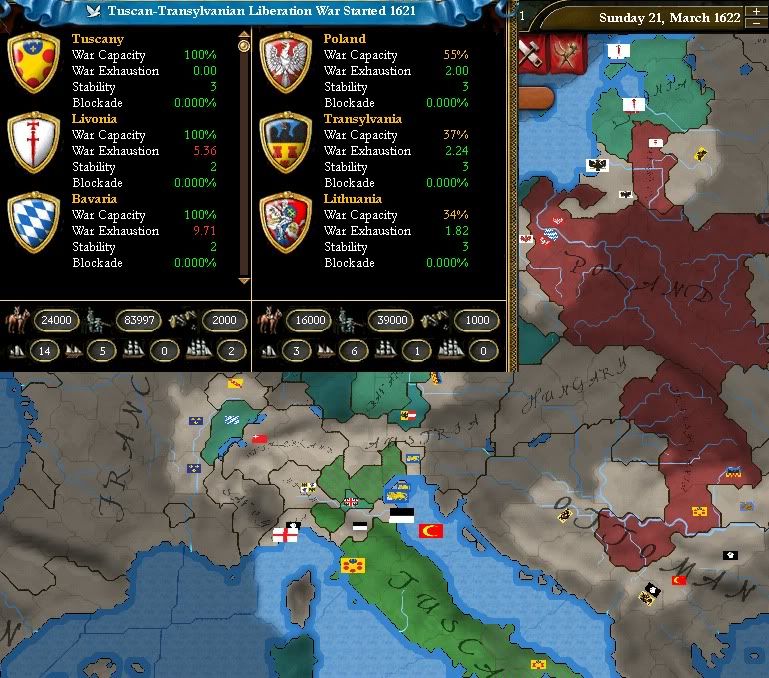
Marching through the Habsburg occupied Balkans, he reached Serbia in February of 1622 and quickly defeated the Transylvanian army. Upon crossing the Danube, the Duke's army surrendered to Carlo. With a grandiose proclamation of his generosity, Carlo carved a new Serbian Kingdom from the Transylvanian conquests.
Poland, however, was no pushover. A Bavarian army assaulted key castles along their western borders while the Livonians overran the small Lithuanian forces. Following his victory in the Balkans, Carlo marched north through Hungary to besiege Krakow. Faced with the Polish winter, inadequate supplies, and inferior numbers, he was forced to withdraw the siege as 1622 came to a close. After an inconclusive spring, Lithuania ceded Troki to Livonia and the Poles agreed to a truce. The Crusade finished without quite the glorious victory that it had started out being in Transylvania.
Carlo took out his frustration on Hungarian nobles rebelling against his Medici cousin on his way back to Tuscany. Having made an enemy of Poland, Carlo secured his marriage to a Russian princess in the hopes of forging a future ally against Poland and the Muslim Turks, though this never fully panned out.
A Heavy Crown
For the next few years, Carlo focused his attention inward, as he built more infrastructure to unite his domains, including establishing the first national postal system. But his ambition for conquest was never satisfied. By 1629, Carlo had convinced the new Emperor, Joseph Ludwig I, that the Habsburgs intended to annex their Milanese vassal. Intent on strengthening the Imperial crown's authority, Joseph was convinced, and agreed to declare war on Austria with the goal of liberating Milan, a decision that would prove to accomplish just the opposite.
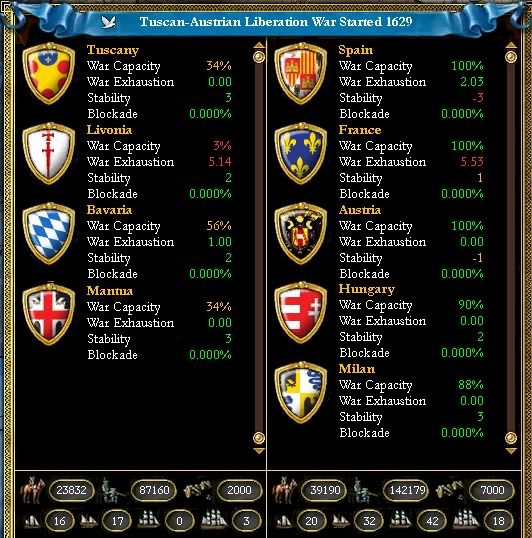
Both Spain and France came to the Habsburgs' aid against their Protestant enemies, and religious war once again engulfed most of western Europe.
As the Spanish fleet and the French army mobilized, the Tuscan armies under Carlo marched into the Duchy of Milan. With 11,000 men, the Duke knew he could not defeat Carlo but hoped to tie him down long enough for the Habsburgs to lay waste to northern Italy or the Spanish to destroy Tuscan shipping. Unfortunately for him, Carlo caught the Milanese army at night, camping near Pavia. Forcing them into a hasty retreat, they were led into a trap, and the entire army was killed or captured. Milan fell in less than a month.
The French once again poured into the Franch-Comte and the Netherlands as most of the Bavarian army was tied up fighting Austria. With the quick defeat of Milan and most of the Austrians distracted, Carlo marched through northern Italy while his generals led a second army into Tyrolia. Carlo soon defeated the main Habsburg army and Austria was all but defeated, but the French continued to overrun the Bavarian Netherlands.
Meanwhile Ferraran Catholic guerrilas hampered Carlo's supply trains from Tuscany. Carlo convinced the Emperor to declare war on Ferrara as well, with the goal of re-establishing Protestant Modena. This brought the rest of Catholic Italy (minus Sardinia) into the war.
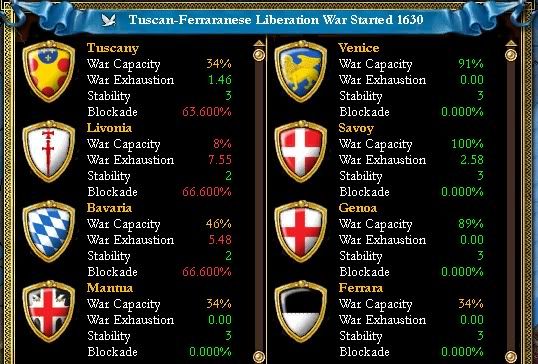
Pulling most of his forces south to invade Ferrara, Carlo left Emperor Joseph to finish off Austria. This allowed the Habsburgs to regroup and form another army, which succeeded in attacking into Bavaria itself. Completely unable to defend his Imperial Demesne and wanting to focus on Austria, the French were able to negotiate a quick exit with the Emperor, leaving the Netherlands in exchange for adding Franche-Comte to the French Crown.
The Ferraran war was slow going. The walls of Modena and Ferrara had been heavily strengthened over the years and their troops were dug in. Spanish and Genoese fleets blockaded Tuscany, and small armies continously harassed Parma and the coastal cities of Pisa, Siena, and Rome.
By the summer of 1631, however, the war was decided. Now fully focused on Austria, the Emperor had crushed their army and was pushing on Vienna. The Ferraran forts began to surrender one by one and the Spanish blockade and raiding parties were proving ineffective as the Spanish struggled to maintain their worldwide empire.
In July of 1632, having been decisively defeated, Austria and Ferrara agreed to come to terms. With Bavaria still in flames from Austrian plunder, Carlo ignored the battered and weak Emperor's protests as he annexed Lombardia and Modena and plundered the Ferraran treasury.
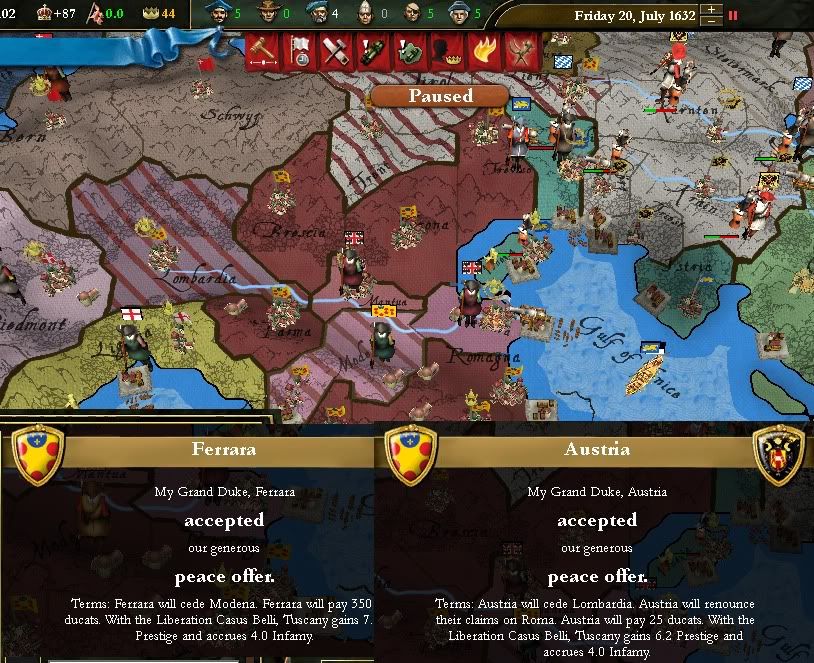
Now fully in control of his own destiny, the Empire and Europe watched in shock as Carlo seized the Iron Crown in Milan and crowned himself King of Italy on September 3, 1632. The Emperor declared Carlo an outlaw and enemy of the Empire, but it didn't matter. After years of war, only Carlo's Italy and Louis XIV's France were in any condition to fight, and for the moment, Louis was enjoying watching the Empire go down in flames.

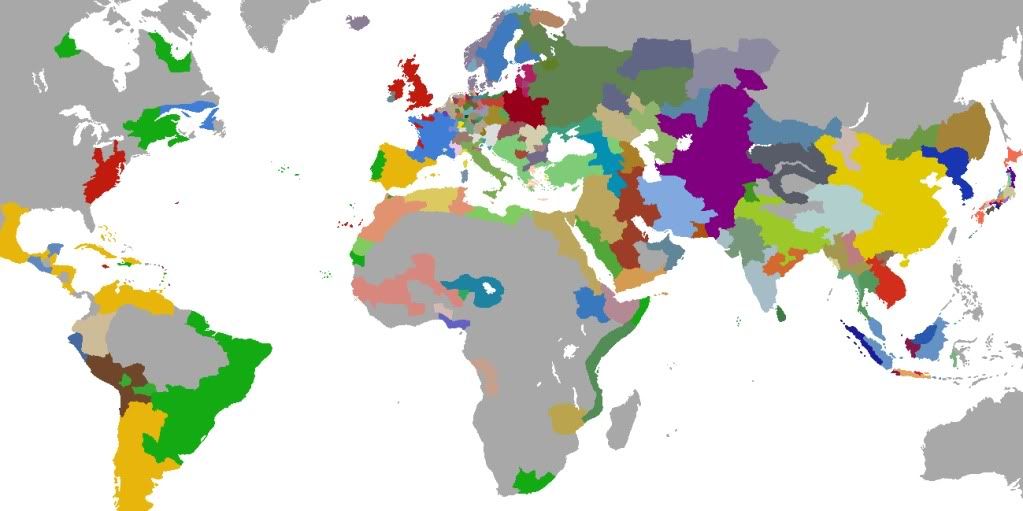
The World, at Carlo I's coronation as King of Italy, 1632
My Take the Iron Crown decision requires owning (or vassalizing the owner of) Milan, being Italian culture, and being a Major Power (kingdom-level). It grants cores on the areas surrounded by the red line below (basically Imperial Italy + Sardinia & Istria - I have taken Istria out since this playthrough for the submod I intend to release). Only Milan and Modena I had not cored yet. However it also kicks you out of HRE, some infamy, and massive relations hit with virtually everybody. My Grant the Iron Crown decision is much more restrictive and requires legitimacy/infamy/relations with Emperor etc but is a bit more peaceful.
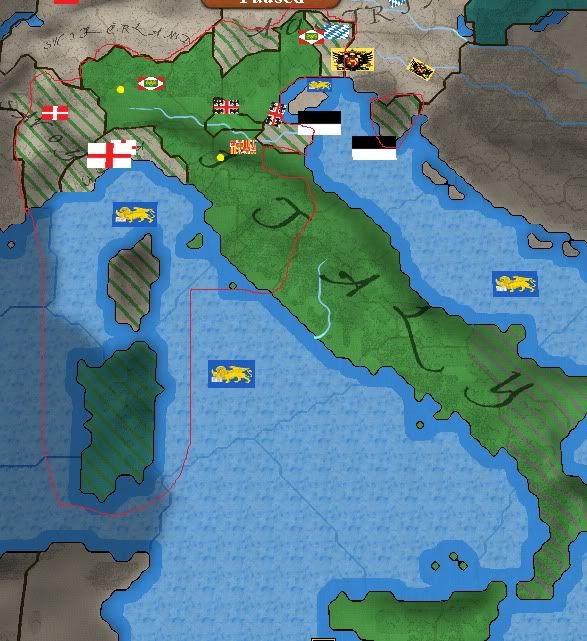
Chapter X - Italian Ambitions
"You may have the universe if I may have Italy."
-Giuseppe Verdi
The Throne of Naples
With pirates becoming an increasing threat along Tuscany's much extended coastline, Carlo I's first act as Grand Duke was to pass a harsh new anti-piracy law.
His second act was to anull the treaty with France and Naples, and on February 1, 1615, he declared war on the fledgling kingdom of Naples, renewing his father's claim to the throne as his right.

Henri III of France was in a tight spot to help his cousin this time around, as the French navy and professional army were in the New World fighting Mayans in the Yucatan. Spain was stable and at peace, so any attempt to stretch French forces further might provide the Spanish with a perfect opportunity to retake the Pyrenees. Furthermore, Austria and its allies, including Bavaria, were busy Crusading against the Turks. Though the Habsburgs considered coming to Naples' defense to try to keep Italy fractured, the Emperor Maximilian's immediate declaration of support for Tuscany meant they'd risk turning the Emperor from an ally to an enemy when they needed him most.
Nevertheless, the Italian states (except Milan who was involved in the Crusade as well) condemned the Tuscan aggression and began mobilizing for war. But it was Carlo who was prepared to fight. With 12,000 men, he invaded Naples from the northeast. Alfonso II hurriedly took control of his Neapolitan army and fled the city north to attack Roma, but in vain. Carlo's well-trained troops and engineers, combined with spies and sympathizers working in the city itself, took control of Naples in only 11 days. Carlo then marched north and defeated Alfonso outside Rome, and the Kingdom of Naples was added to the Crown of Tuscany. Carlo then marched north to face the Ferraran army besieging Florence. They fought galiantly but were overwhelmed by the superior Tuscan forces. Fighting in Ferrara (including Modena) against Ferraran and Genoese militias continued for months, as the Ferraran towns and cities put up staunch resistance in the hills of central Italy.
In the north, Carlo's second army of 16,000 men marched into Venetian territory and captured Friuli within two weeks. Securing passage through Habsburg Austria, they reached Istria two months later.
Seeing the stiff resistance of Ferrara and Genoa, the Emperor called for peace since Carlo had gotten what he wanted: Naples. While Carlo clearly had his eyes on annexing Ferrara, he was in no position to take on the Emperor himself, and did not want to cause the Crusade against the Turks to fall apart. With minor concessions from Venice, he agreed to a truce.

The "Slavic Crusade"
Having secured the throne of Naples for himself, the ambitious Carlo began looking for more battles. Italy was off-limits for the time being.
The Habsburg-Ottoman war continued to rage in Croatia and Slovenia, and in 1618 France, having been somewhat humiliated by the Mayans in the Yucatan jungles, redirected its forces against the Turkish threat. However, the Habsburgs refused to let the heretic Carlo join the Crusade.
By late 1619, the Ottoman's hold on the Balkans began to collapse as Austrian forces broke through in Croatia. Revolts broke out all along the Danube as Hungarian, Croatian, Serbian, and Bulgarian rebels stormed Ottoman garrisons. As the Ottoman state temporarily collapsed, the opportunisitc Duke of Transylvania invaded from the north, seizing Belgrade for himself.
Grand Duke Carlo saw an opportunity. Diplomatically prevented from joing the war against the Turks, he declared his own 'Crusade' of liberation against Transylvania in support of Serbian nationalists. Transylvania was protected by the King of Poland, however Carlo responded by calling in his newest ally, the newly Protestant Duke of Livonia.

Marching through the Habsburg occupied Balkans, he reached Serbia in February of 1622 and quickly defeated the Transylvanian army. Upon crossing the Danube, the Duke's army surrendered to Carlo. With a grandiose proclamation of his generosity, Carlo carved a new Serbian Kingdom from the Transylvanian conquests.
Poland, however, was no pushover. A Bavarian army assaulted key castles along their western borders while the Livonians overran the small Lithuanian forces. Following his victory in the Balkans, Carlo marched north through Hungary to besiege Krakow. Faced with the Polish winter, inadequate supplies, and inferior numbers, he was forced to withdraw the siege as 1622 came to a close. After an inconclusive spring, Lithuania ceded Troki to Livonia and the Poles agreed to a truce. The Crusade finished without quite the glorious victory that it had started out being in Transylvania.
Carlo took out his frustration on Hungarian nobles rebelling against his Medici cousin on his way back to Tuscany. Having made an enemy of Poland, Carlo secured his marriage to a Russian princess in the hopes of forging a future ally against Poland and the Muslim Turks, though this never fully panned out.
A Heavy Crown
For the next few years, Carlo focused his attention inward, as he built more infrastructure to unite his domains, including establishing the first national postal system. But his ambition for conquest was never satisfied. By 1629, Carlo had convinced the new Emperor, Joseph Ludwig I, that the Habsburgs intended to annex their Milanese vassal. Intent on strengthening the Imperial crown's authority, Joseph was convinced, and agreed to declare war on Austria with the goal of liberating Milan, a decision that would prove to accomplish just the opposite.

Both Spain and France came to the Habsburgs' aid against their Protestant enemies, and religious war once again engulfed most of western Europe.
As the Spanish fleet and the French army mobilized, the Tuscan armies under Carlo marched into the Duchy of Milan. With 11,000 men, the Duke knew he could not defeat Carlo but hoped to tie him down long enough for the Habsburgs to lay waste to northern Italy or the Spanish to destroy Tuscan shipping. Unfortunately for him, Carlo caught the Milanese army at night, camping near Pavia. Forcing them into a hasty retreat, they were led into a trap, and the entire army was killed or captured. Milan fell in less than a month.
The French once again poured into the Franch-Comte and the Netherlands as most of the Bavarian army was tied up fighting Austria. With the quick defeat of Milan and most of the Austrians distracted, Carlo marched through northern Italy while his generals led a second army into Tyrolia. Carlo soon defeated the main Habsburg army and Austria was all but defeated, but the French continued to overrun the Bavarian Netherlands.
Meanwhile Ferraran Catholic guerrilas hampered Carlo's supply trains from Tuscany. Carlo convinced the Emperor to declare war on Ferrara as well, with the goal of re-establishing Protestant Modena. This brought the rest of Catholic Italy (minus Sardinia) into the war.

Pulling most of his forces south to invade Ferrara, Carlo left Emperor Joseph to finish off Austria. This allowed the Habsburgs to regroup and form another army, which succeeded in attacking into Bavaria itself. Completely unable to defend his Imperial Demesne and wanting to focus on Austria, the French were able to negotiate a quick exit with the Emperor, leaving the Netherlands in exchange for adding Franche-Comte to the French Crown.
The Ferraran war was slow going. The walls of Modena and Ferrara had been heavily strengthened over the years and their troops were dug in. Spanish and Genoese fleets blockaded Tuscany, and small armies continously harassed Parma and the coastal cities of Pisa, Siena, and Rome.
By the summer of 1631, however, the war was decided. Now fully focused on Austria, the Emperor had crushed their army and was pushing on Vienna. The Ferraran forts began to surrender one by one and the Spanish blockade and raiding parties were proving ineffective as the Spanish struggled to maintain their worldwide empire.
In July of 1632, having been decisively defeated, Austria and Ferrara agreed to come to terms. With Bavaria still in flames from Austrian plunder, Carlo ignored the battered and weak Emperor's protests as he annexed Lombardia and Modena and plundered the Ferraran treasury.

Now fully in control of his own destiny, the Empire and Europe watched in shock as Carlo seized the Iron Crown in Milan and crowned himself King of Italy on September 3, 1632. The Emperor declared Carlo an outlaw and enemy of the Empire, but it didn't matter. After years of war, only Carlo's Italy and Louis XIV's France were in any condition to fight, and for the moment, Louis was enjoying watching the Empire go down in flames.


The World, at Carlo I's coronation as King of Italy, 1632
My Take the Iron Crown decision requires owning (or vassalizing the owner of) Milan, being Italian culture, and being a Major Power (kingdom-level). It grants cores on the areas surrounded by the red line below (basically Imperial Italy + Sardinia & Istria - I have taken Istria out since this playthrough for the submod I intend to release). Only Milan and Modena I had not cored yet. However it also kicks you out of HRE, some infamy, and massive relations hit with virtually everybody. My Grant the Iron Crown decision is much more restrictive and requires legitimacy/infamy/relations with Emperor etc but is a bit more peaceful.

Wonderful news that Italy has finally been brought under the rule of a single dynasty. But please, make a new CoA for Italy to fit the splendour of a peninsular ruled by the heirs of Tuscany instead of that silly Corsican eagle.
Great AAR btw.
Great AAR btw.
At last, this AAR is alive and kicking! 
That was one really good entry, you've spend like, how much, 15 or 20 years in state of constant warfare and then you just claimed the throne of whole Italy for yourself. I think now you'll spend some time uniting all your cores and then, well, world is your playground
Also: this huge country in central Asia, Ferghana I think, is seriously scary
That was one really good entry, you've spend like, how much, 15 or 20 years in state of constant warfare and then you just claimed the throne of whole Italy for yourself. I think now you'll spend some time uniting all your cores and then, well, world is your playground
Also: this huge country in central Asia, Ferghana I think, is seriously scary
Surprised you coughed up Modena (at least temporarily)! I guess France is a monkey worth getting off one's back relatively quickly, though.
Also, good job on uniting most of Italy. How's the infamy holding up? I'm assuming as a fellow MMU player, you are being cautious about tiptoeing up to even half the BB limit, lest Cardinal Richelieubik's agents get enough dirt to frame you for something awful.
And hell yeah that big purple blob in central Asia looks scary (AhhOOGA AhhOOOOGA).
Also, good job on uniting most of Italy. How's the infamy holding up? I'm assuming as a fellow MMU player, you are being cautious about tiptoeing up to even half the BB limit, lest Cardinal Richelieubik's agents get enough dirt to frame you for something awful.
And hell yeah that big purple blob in central Asia looks scary (AhhOOGA AhhOOOOGA).
Wonderful news that Italy has finally been brought under the rule of a single dynasty. But please, make a new CoA for Italy to fit the splendour of a peninsular ruled by the heirs of Tuscany instead of that silly Corsican eagle.
Great AAR btw.
Thank you, but what should I use for Italy's CoA then?
Also: this huge country in central Asia, Ferghana I think, is seriously scary
And hell yeah that big purple blob in central Asia looks scary (AhhOOGA AhhOOOOGA).
That is Transoxiana, and yes it is huge but no threat to me. It is tribal as well so it will eventually collapse from getting so big.
I'm assuming as a fellow MMU player, you are being cautious about tiptoeing up to even half the BB limit, lest Cardinal Richelieubik's agents get enough dirt to frame you for something awful.
lol @Richelieubik, but yeah at this point I had 0 infamy +4 Milan +4 Modena, and I think +5 for forming Italy = 13.

